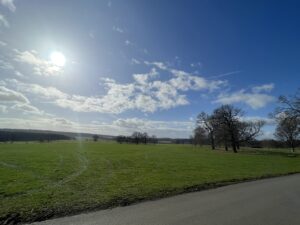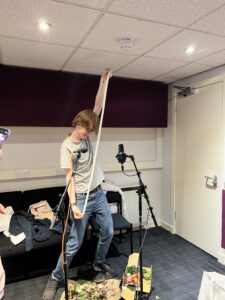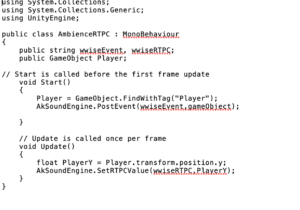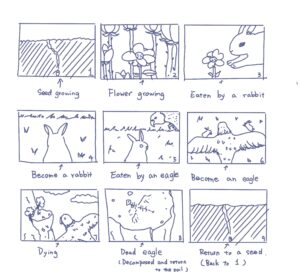Sound Design – Storyboard Cues
Following the final storyboard being shared with the group and posted on the blog, I have adapted the ideas discussed in my previous post in accordance with the storyboard. Upon reading the storyboard, I decided that it would be a good idea to compose this document, and for it to serve as a plan for the soundscape of each cue/stage in the storyboard. It marks a slight change in approach to the overall structure of the sounds. It takes a more linear and rigid approach that more closely follows the cues in the storyboard – rather than thinking of it more fluidly, as I did in the previous post. Having a solid idea of what each stage needs and how it should sound I believe will prove very useful when it comes to deciding what sounds are needed for the project, gathering and organising them, and as something to refer back to when crafting the soundscape in Wwise.
1 – The seeds are in the soil, and the player sees darkness.
The sound in this stage is perhaps the most important stage in terms of sound. Not only is it the very first stage that will be experienced by the player, but it is also the only stage where the player is not given anything visual to direct their focus towards. The context must instead be given to the player by what they can hear. Under the soil, the player will be able to hear the muffled sounds of wind, and the rain hitting the ground above them, the sounds of other plants nearby growing, the sound of insects and worms moving in the soil around them. As the player is underground, the sound that will be most present will be the insects and worms. The other sounds are happening above the soil, so they will need to sound a little more distant and muffled. The main aims of the soundscape in this stage are to give the player something to latch on to, to provide some context of where they are and the environment around them, and through achieving these, give the player a positive first impression of the experience.
2 – After the rain, the seed break through the soil and the player can see a light, as well as the soil around them, player can see the sky and some trees.
The second stage is also a very important moment when it comes to sound. It marks the player’s first proper introduction to the environment above-ground. The soundscape in this stage will start to open up and flourish, much like the seed that the player is experiencing the world through. The player finally sees the world, and the soundscape needs to reflect this new place the player now finds themselves in. Sounds that were muffled and distant begin to move closer to the player in this stage, and new sounds that were unable to reach the player in the previous stage are now audible, such as the sound of grass and leaves blowing in the wind and a cacophony of birdsong.
3 – The seeds turn into saplings and see the big trees around them.
As the seed grows into a sapling, the soundscape continues to open up and encompass more of the forest around the player. Birds can be heard more clearly, including the flapping of their wings as they pass by. The wind is now also heard whooshing through the trees, instead of just the sounds of the grass and leaves being blown around.
4 – The sapling is gradually growing taller and the player can see flowers, mushrooms and other plants around it.
In this stage, the player now begins to see much more of the plant life that surrounds them close to the ground. The presence of flowers and mushrooms, while not typically sources of sound, I feel should still be represented sonically in some way. The sounds of insects that live above ground are also now present in the soundscape, such as bees, wasps and other winged insects.
5 – Players can see some animals running around
Following the introduction of flowers and mushrooms, as well as the introduction of winged insects to the soundscape, the player is then introduced to the mammals that inhabit the forest. These could be animals like rabbits, foxes, deer, squirrels, and frogs. I am aware that terrestrial animals are currently being modelled, and that considering the scope of the project, it is likely only a select few will be visible to the player. However, at this stage the player’s view of the forest is confined to a reasonably small area, which leaves room for the soundscape to give sound to animals that are not visible to the player, to help create a sonic atmosphere suitable for a forest that is full of life. The soundscape can suggest things beyond what the player is able to see during this stage. For the animals that are visible, the sounds of their footsteps on the grass and leaves will be heard, and there will need to be a good deal of variety in these to match the size and weight of the particular animal in question.
6 – The small tree gradually grows into a large tree, looking at the surrounding landscape from a top view.
As the player grows to a height where the environment is seen from a near bird’s eye view, the sounds of the forest take on a different nature, that is appropriate to the newfound heights the tree has reached. The environmental sounds, while still very much present, become more distant, as the tree’s growth moves the player’s perspective further and further from the ground. The wind sounds will also take on a different character.
7 – The player can see small animals on the trunks of the surrounding trees, e.g. pine trees,birds.
In this stage, the player’s view now includes the leaves and branches of taller trees. This is the first time that the player will be able to see and hear the sounds of leaves that are not on the ground, but are part of other trees – at least this closely. The sounds of animals on the branches of these other trees can now be heard.
8 – The tree grows taller and taller, becoming the largest tree in the forest, overlooking the whole forest
This stage marks the peak in the height of the tree, as well as the peak in how much of the environment the player can see. Just as the player overlooks the entire forest, they should also be able to hear the entire forest. The growth of the tree throughout the previous stages has all culminated in this moment, and the scope of the soundscape should serve to reflect this.
9 – At night, the forest caught fire. The trees were in flames.
This stage in the story represents an incredible shift in the soundscape. The tree has caught fire and is now burning down. The sounds of the fire will need to be intense and feel very close and immediate to the player.
10 – The tree was consumed by fire and plunged into darkness; it rained and doused the fire
Following the destruction of the tree and many of its surrounding neighbours, rain begins to fall that extinguishes the fire, an event that demands quite an intense accompanying soundscape.
11 – Large trees transfer nutrients to other trees through the Wood Wide Web before they die out completely.
As the nutrients from the dying tree the player has been inhabiting transfers through its roots to smaller trees in the surrounding area, synthesised sounds will be heard, that represent the final act of the tree – providing nutrients so that another tree may take its place. The sounds of the nutrients flowing will begin very close to the player and become more distant and spacialized as they travel underground through the forest.
12 – A small tree by a lake gets the nutrients of a large tree to grow fast.
During the final stage, the player is no longer inhabiting a particular tree, but is instead watching as the final act of the tree breathes new life into the forest following the blaze, with soft music accompanying this renewal.






